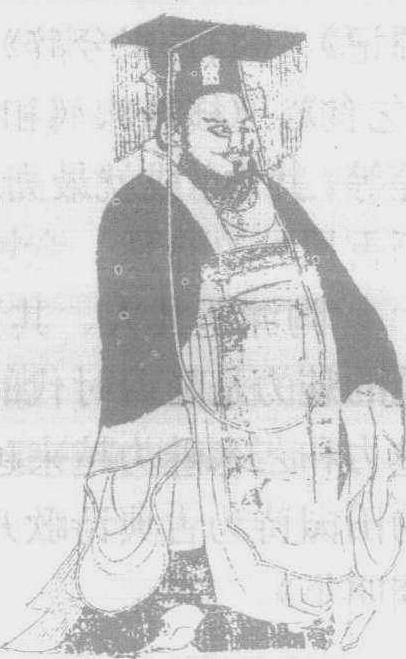039 曹丕187—226
即魏文帝。曹操次子,三国时魏国的建立者。文学家、文学理论家。公元220—226年在位。字子恒。爱好文学,尤长于诗。诗作内容主要反映贵族的生活和感情,在形式上颇受民歌影响,语言通俗,描写也较细致;其《燕歌行》是现存最早的文人七言诗。另外有《典论·论文》传世,是我国较早的文学批评著作。有 《魏文帝集》。
曹丕187—226CaoPi
三国时魏文学家。字子桓,曹操之子。少时博学多能。建安十六年(211),为五官中郎将、副丞相,建安二十二年立为魏太子,二十五年代汉帝自立,做了七年皇帝后病卒于洛阳。
文学成就以诗歌为主。今存诗约40首,一半为乐府诗。内容可分为两大类,一类描写诗人的生活经历。包括他为公子和太子在邺城宴饮欢娱时生活的写照,如《芙蓉池作》、《夏日诗》;以及他参与军事活动的真实感受,如《黎阳作》三首、《至广陵于马上作》。另一类是拟作的游子思妇词。如《杂诗》写游子思乡的心情,以“西北有浮云”起兴,具有汉乐府民歌的风味。《燕歌行》两首,是现存最早的完整的七言诗,对七言诗体的形成有贡献。第一首触物起兴,描写秋天萧瑟的景象,引起思妇怀念远方丈夫的悲伤心情,情景交融,委婉动人。但在形式上句句押韵,缺少变化。
曹丕雅爱文士。两篇《与吴质书》,悼念亡友,叙说旧谊,感情诚挚。又著有《典论·论文》,是现存最早的文学和批评专著。其中提出“盖文章,经国之大业,不朽之盛事”、“诗赋欲丽”等观点,特别是提出了著名的“文气说”,对此后的文学创作和文学批评有积极影响。另外还分别评价了建安“七子”的文学创作,批评了文人相轻的风气。这都对建安文学的发展起了推动作用。
诗集可参考:黄节《魏武帝魏文帝诗注》,人民文学出版社1958年重排出版。
曹丕187—226
三国时魏国建立者。即魏文帝。公元220~226年在位。将领、文学家。字子桓,沛国谯(今安徽亳县)人。曹操次子。建安十六年(211年)任五官中郎将、副丞相。建安二十二年(217年)被立为魏太子。曹操死后,嗣位为丞相、魏王。此时,改变了曹操抑制豪强的政策措施,实行九品中正制,确立门阀士族在政治上的特权地位。延康元年(220年),代汉称帝,改元黄初,都洛阳,国号魏。黄初二年(221年),遣张既平定河西。黄初三年(222年)及五年(224年),先后两次亲率大军伐吴,皆未果而还。好文学,现存《燕歌行》等四十首诗歌,还有我国较早的文学批评专著《典论·论文》,尚有《魏文帝集》。
曹丕187—226
三国时政治家、文学家。字子桓。沛国谯 (今安徽省亳县)人。曹操次子。建安十六年(211年)为五官中郎将。建安二十二年(217年)立为魏太子。建安二十五年(220年)代汉帝即位,为魏文帝。曹丕在位七年,在军事上、政治上都没有什么突出的建树。但他好文学,礼重文人,以著述为事,在文学史上有一定的地位。其诗现存四十首,其中一半是乐府诗。他善于运用清新晓畅、形象鲜明的语言,描写男女爱情和离愁别恨,但题材较狭窄,内容贫乏,成就远不及曹操、曹植。代表作《燕歌行》是我国现存的最早最完整的文人七言诗,为后来七言诗的发展奠定了基础。他的散文成就较高,尤其擅长书信。著名的《典论·论文》,是我国文学批评史上第一篇文学理论批评专著。它阐述了文学的社会地位和社会作用,指出了各种文体的特点,论述了作家个性与作品风格问题和文学批评的态度问题,在我国文学批评史上占有重要的地位。《隋书·经籍志》著录其《典论》五卷、《列异传》三卷、文集二十三卷,已散佚。明人辑有 《魏文帝集》。
曹丕187~226
字子桓,沛国谯县(今安徽亳县)人,三国时魏国的建立者和文学家。他是曹操的次子,曹操死后,继承父位为魏王,公元220年代替东汉称帝,定都洛阳,国号魏,为魏文王。
曹丕6岁会射箭,8岁会骑射,好击剑,喜博览。他的胆气胸怀虽逊于其父曹操,文采气质虽不如其弟曹植,但他有雄心,有毅力,工于心计。在与曹植争夺太子位时,他取得了胜利。
曹丕很喜好文学,博闻强记,下笔成章。他作的诗赋有100多篇,现存约40余篇。其代表作《燕歌行》是现存最早、最完整的文人七言诗。曹丕诗歌的风格细腻委婉,语言浅显清丽,多描写感情生活。
曹丕也比较擅长写散文,著有 《典论》一书,大部分已散失,较完整的只有 《自叙》和 《论文》两篇。《论文》是我国较早的文学批评著作。此外,他的《与吴质书》、《又与吴质书》 二篇悼念亡友的散文,写得凄楚感人,对后来抒情散文的发展有很大影响。现有《魏文帝集》。

曹丕
提出“文气说”。认为“文以气为主”。“文气”是作家精神气质等个性特征以及对现实生活的独特审美体验,是作品美感力量的源泉。艺术欣赏是对“文气”的体验。参见“文学”中的“曹丕”。
曹丕187—226
即“魏文帝”(220—226)。字子桓,曹操次子。建安二十二年(217年)立为王太子。二十五年(220年)曹操死,袭位为魏王,任丞相。同年十月,废汉献帝自立,建立曹魏政权,改元黄初,都洛阳。在位期间,推行九品中正制度,规定以门第定官品高低,确立了门阀士族在政治上的特权,获得世家大族支持。他爱好文学,以著述为务,所著《典论·论文》是文学评论方面的较早著作,在中国文学史上具有一定的地位。参见“文学”中的“曹丕”。
曹丕187—226
三国魏文学家。死后谥文,称魏文帝。爱好文学,为当时文坛领袖。其诗颇受民歌影响,通俗清丽,抒情细腻,代表作《燕歌行》为现存最早的文人七言诗。另有《典论·论文》为中国较早的文学批评专著。变擅散文,文笔清新流丽,尤以书信著名。原有集二十三卷、《典论》五卷、《列异传》三卷,已散佚。明人辑有《魏文帝集》。参见“美学”、“历史”中的“曹丕”。
曹丕187—226
三国魏文帝,文学家。字子桓,曹操次子,沛国谯(今安徽亳县)人。曹操死后,袭位为魏王,行九品中正制。不久代汉即帝位,为魏文帝,建都洛阳,在位七年。曹丕爱好文学,并大力提倡创作,常与文人名士唱和,为邺下文人集团核心。作品有诗、赋、书、论等,其诗题材内容较窄,多反映贵族阶级的生活感情,善写男女之爱、离情别恨。在形式上受民歌影响较深,语言通俗。其《典论·论文》、《与吴质书》是中国古代较早的文学理论批评著作,在文学批评发展史上有重要作用。明人辑有《魏文帝集》,近人黄节有《魏文帝诗注》。
曹丕
曹丕187—226
字子桓。沛国谯县(今安徽亳县)人。曹丕的《典论·论文》是散文美学史上较早地运用宏观的方法,多角度地论述文学理论的专篇。在此之前,先秦诸子的文论,多属只言片语,淹没在哲学和政治的论述之中。到了汉代,已出现用序、赞形式来讨论文学的,但往往只讨论某一具体作家的作品,限于一篇一书,没有宏观意识,所以《典论·论文》有开创性。曹丕以帝王之尊,推崇文艺,提倡开展文艺批评,这在文艺美学史上具有特殊地位。在《与吴质书》中,他扼要而公允地肯定了陈琳、刘桢、王粲诸人的文学成就,特别是散文创作的成就,也指出其不足之处。它与《典论·论文》都是散文美学史上最先对一个创作群体进行全面总结的文字。文中“后生可畏,来者难诬”的观点,包含着文学将不断发展的思想,也与《典论·论文》中“贵远贱近,向声背实”的批评精神相一致。
曹丕187——226
字子桓。沛国谯县(今安徽毫县)人。曹操长子。少有逸才,博览群书。建安十六年(211年)为五官中郎将、副丞相,后立为太子。曹操卒,他嗣位为丞相、魏王,不久又代汉称帝,都洛阳,国号魏。曹丕爱好文学,常与当时的著名文人宴饮唱和,往来甚密,是邺下文人集团的核心人物。曹丕的散文以书信为佳,代表作如《与吴质书》,语言质朴诚恳,令人感到亲切。其文笔清新流利,对后世短篇抒情散文的发展有一定影响。他的《典论》作为一部政治、文化论著,亦是重要的散文作品。
曹丕
曹丕187~226
字子桓。即魏文帝。曹操次子。东汉建安十六年(211)为五官中郎将、副丞相。二十二年立为太子。曹操死,嗣位为丞相、魏王,旋代汉称帝,国号魏,都洛阳。在位期间,效法汉文帝实行清静无为,与民休息政策,制订“九品中正法”.使世族门阀统治开始确立。好文学,为当时文坛领袖。其诗“燕歌行”为现存最早一首七言诗。所著《典论·论文》为我国较早之文艺理论批评专著。现存诗歌约40首。有《典论》5卷、《列异传》3卷,文集23卷,已散佚。明人辑有《魏文帝集》。谥文帝。
曹丕187—226
即魏文帝。字子桓,沛国谯(今亳州)人。三国时魏国的建立者,文学家,曹操次子。年八岁,能属文,有逸才,通古今经传、诸子百家之书。善骑射,好击剑。建安十六年(211)为五官中郎将、副丞相。二十二年(217)立为魏太子。曹操死,嗣位为丞相,魏王。推行九品中正制,确立和巩固士族门阀在政治上的特权。不久代汉称帝,都洛阳,国号魏。在位七年。曹丕天资聪颖,下笔成章。博闻强识,与其父曹操、弟曹植皆为建安文学的代表人物。创作和理论都有成就。所著《典论·论文》是我国文学史上的最早文论,对我国文学批评的发展颇有贡献。散文成就较高,尤擅长书信。明人辑有《魏文帝集》。
曹丕187~226
三国魏文学家。字子桓,沛国谯 (今安徽毫县) 人。曾任五官中郎将,后立为魏太子,建安25年代汉称帝,国号魏,死后谥文,称魏文帝。与父曹操、弟曹植并称“三曹”。原有集23卷,已佚,明人辑有《魏文帝集》。其诗多写男欢女爱和旅愁闺思,形式多种多样,而五言七言为其所长。五言如《清河作》、《杂诗》等或写对爱情的憧憬,或写客寄他乡的愁怀,均情切意婉。七言以《燕歌行》著称于世,缠绵悱恻,晓畅清丽,足为其诗风格代表; 而且在七言诗史上具有重要地位。其文亦佳,《与吴质书》、《又与吴质书》叙述对友人的思念或哀悼,凄楚动人。《典论·论文》则开文学批评之风,对后世影响颇大。
曹丕
三国时期魏国皇帝。曹操第2子。生于公元187年。公元211年,任副丞相、五官中郎将。217年被立为太子。220年曹操死后,继任为魏王、丞相。同年10月,他威逼汉献帝刘辨退位,自立为帝,改元黄初,迁都洛阳。他推行九品中正制,设立中书省,曾3次率军伐吴。他在位7年,于226年去世,年仅40岁。他的七言诗有相当成就。